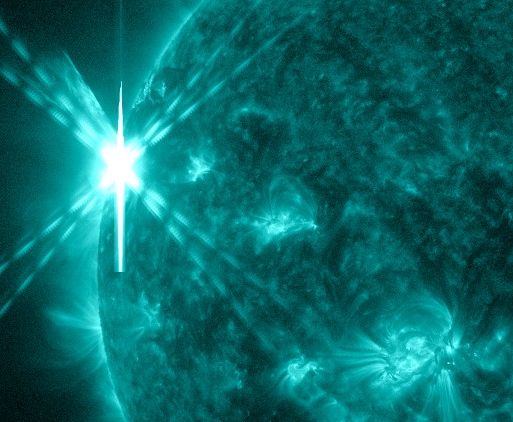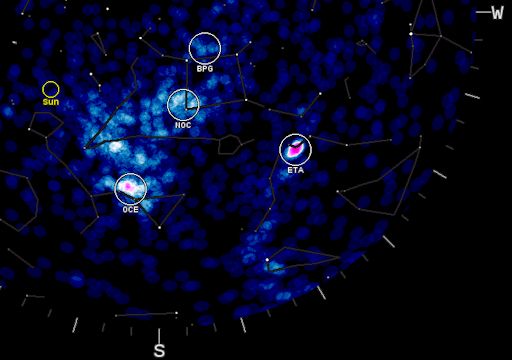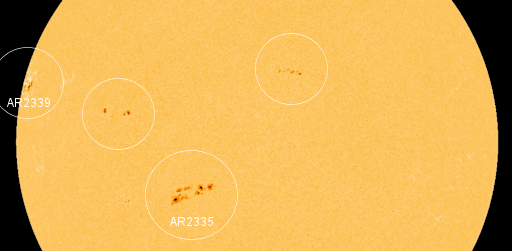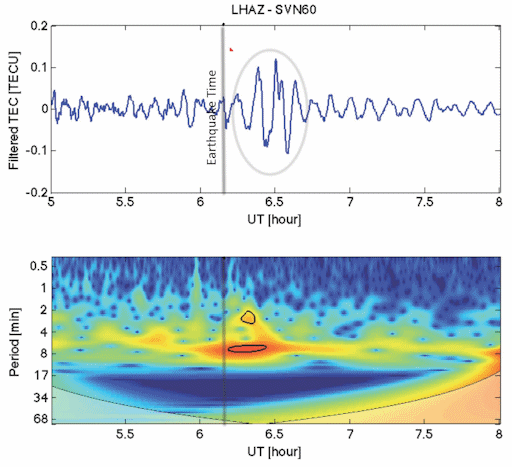Come to Tromsø and share Marianne's passion for rural photography: Chasethelighttours.co.uk invites you to experience "Heaven on Earth" with an aurora, fjord, fishing, whale watching, photography or sightseeing tour. | | |
MINOR STORM WARNING: A coronal mass ejection (CME) hurled into space by a solar filament eruption on May 2nd is heading for Earth. ETA: May 6th. NOAA forecasters estimate a 45% chance of minor geomagnetic storms when the cloud arrives. Aurora alerts: text, voice
X-FLARE! The sun is no longer quiet. Emerging sunspot AR2339 unleashed an intense X2-class solar flare on May 5th at 22:15 UT. NASA's Solar Dynamics Observatory captured the extreme ultraviolet flash:

A pulse of X-rays from the flare caused a strong radio blackout over western parts of North America and the entirety of the Pacific Ocean. This map shows the extent of the blackout, which affected frequencies mainly below 10 MHz. This is the type of event that mariners, aviators, and ham radio operators might have noticed.
The explosion probably hurled a coronal mass ejection (CME) into space, but coronagraph data are not yet available to confirm. Stay tuned for updates. Solar flare alerts: text, voice
METEORS FROM HALLEY'S COMET: The Canadian Meteor Orbit Radar (CMOR) is detecting a "hot spot" in the sky today. Note the circled region labeled "ETA" in the May 5th radar map below. This is a sign that the eta Aquariid meteor shower is underway.

Eta Aquariid meteors come from Halley's Comet. Although the comet itself is more than 5 billion km from Earth, bits of dust from Halley are in the neighborhood. Every year, Earth crosses the debris zone in early May, and we see a meteor shower. The 2015 eta Aquariid display is expected to peak on May 5-6 with 10 to 50 meteors per hour.
The best time to look is during the hours before local dawn on May 6th. Patient sky watchers could see dozens of meteors despite glare from the waning full Moon. Live radar echoes may be heard on Space Weather Radio.
Realtime Meteor Photo Gallery
INCREASING CHANCE OF FLARES: Solar activity is picking up. After a period of quiet last week in which the face of the sun became nearly blank, four significant sunspot groups are emerging. Their dark cores are circled in this Cinco de Mayo image from NASA's Solar Dynamics Observatory:

Two of the sunspot groups, AR2335 and AR2339, are crackling with M-class solar flares. This is causing minor radio blackouts across the dayside of Earth. So far the effects have been restricted to frequencies below ~5 MHz.
More flares are in the offing as these active regions turn toward Earth. Stay tuned for updates. Solar flare alerts: text, voice
Realtime Space Weather Photo Gallery
THE NEPAL EARTHQUAKE AND SPACE WEATHER: High above Earth, more than 60 km above sea level, there is a layer of our planet's atmosphere called "the ionosphere." It is where UV radiation from the sun strips electrons away from the atoms of normal air, creating a zone of charged gas that envelopes the globe.
The ionosphere is very sensitive to solar storms. Turns out, it can be sensitive to earthquakes, too. NASA is reporting that the magnitude 7.8 earthquake in Nepal on April 25th created waves of energy that penetrated the ionosphere and disturbed the distribution of electrons. Note the wave pattern, circled, in the upper panel of this ionospheric electron density plot:

Basically, these are waves of electron density rippling from a point in the ionosphere above the epicenter of the quake. The waves were measured by a science-quality GPS receiver in Lhasa, Tibet. It took about 21 minutes for the waves to travel 400 miles between the epicenter and the GPS receiving station.
The bottom panel of the plot is a "dynamic spectrum." Note the hot spots outlined in black. They show that the ionosphere was ringing with periods of ~2 and ~8 minutes. Presumably, these "tones" are related to atmospheric pressure waves billowing up from the trembling Earth below.
The ionosphere is the stage upon which much of space weather plays out. Auroras, meteors, and noctilucent clouds all occur there. The "Ionosphere Natural Hazards Team" at JPL studies how Earth itself affects this stage via earthquakes, volcanoes and tsunamis. You can read their report about the Nepal earthquake here.
Realtime Aurora Photo Gallery
Realtime Comet Photo Gallery
Every night, a network of NASA all-sky cameras scans the skies above the United States for meteoritic fireballs. Automated software maintained by NASA's Meteoroid Environment Office calculates their orbits, velocity, penetration depth in Earth's atmosphere and many other characteristics. Daily results are presented here on Spaceweather.com.
On May. 5, 2015, the network reported 25 fireballs.
(18 sporadics, 7 eta Aquariids)

In this diagram of the inner solar system, all of the fireball orbits intersect at a single point--Earth. The orbits are color-coded by velocity, from slow (red) to fast (blue). [Larger image] [movies]
Potentially Hazardous Asteroids (
PHAs) are space rocks larger than approximately 100m that can come closer to Earth than 0.05 AU. None of the known PHAs is on a collision course with our planet, although astronomers are finding
new ones all the time.
On May 5, 2015 there were potentially hazardous asteroids.
Notes: LD means "Lunar Distance." 1 LD = 384,401 km, the distance between Earth and the Moon. 1 LD also equals 0.00256 AU. MAG is the visual magnitude of the asteroid on the date of closest approach. | | The official U.S. government space weather bureau |
| | The first place to look for information about sundogs, pillars, rainbows and related phenomena. |
| | Researchers call it a "Hubble for the sun." SDO is the most advanced solar observatory ever. |
| | 3D views of the sun from NASA's Solar and Terrestrial Relations Observatory |
| | Realtime and archival images of the Sun from SOHO. |
| | from the NOAA Space Environment Center |
| | the underlying science of space weather |

